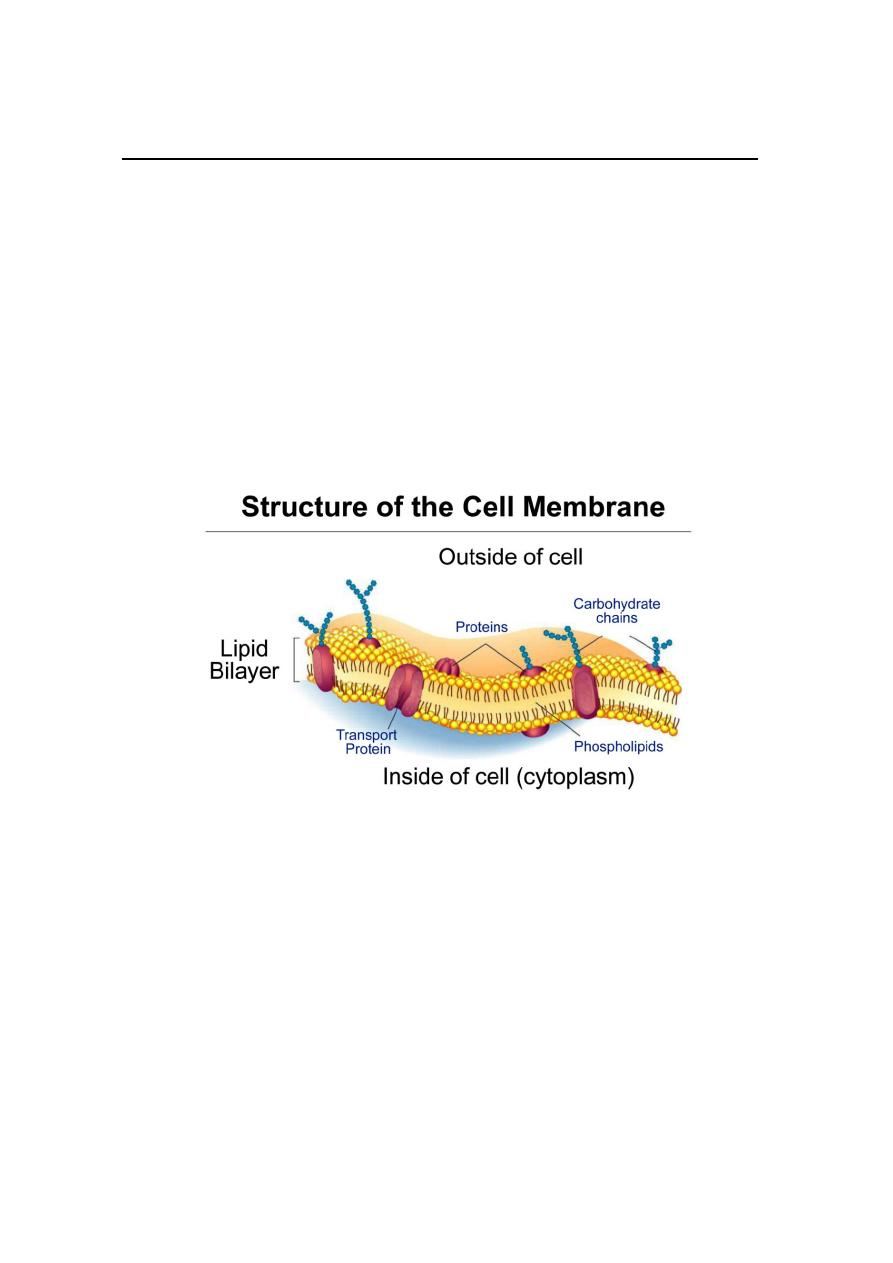
First stage
Biology
Lec-4
14/12/2015
.د
انعام
Cell Biology
Plasma Membrane
Structure of the Plasma Membrane
The cell membrane (or plasma membrane) surrounds all living cells. It
controls how substances can move in and out of the cell and is responsible
for many other properties of the cell as well. The membranes that surround
the nucleus and other organelles are almost identical to the cell membrane.
Membranes are composed of phospholipids, proteins and carbohydrates
arranged in a fluid mosaic structure, as shown in this diagram.
The phospholipids form a thin, flexible sheet, while the proteins "float"
in the phospholipid sheet
like icebergs, and the carbohydrates extend out
from the proteins.
The phospholipids are arranged in a bilayer, with their polar, hydrophilic
phosphate heads facing outwards, and their non-polar, hydrophobic fatty
acid tails facing each other in the middle of the bilayer.
The lipid bilayer is
semi-permeable, allowing only certain molecules to diffuse across the
membrane. Different kinds of membranes can contain phospholipids with
different fatty acids, affecting the strength and flexibility of the membrane.
Animal cell membranes also contain cholesterol linking the fatty acids
together and so strengthening
the membrane.
(1)

The proteins usually span from one side of the phospholipid bilayer to the
other (integral proteins), but can also sit on one of the surfaces (peripheral
proteins). Proteins comprise about 50% of the mass of membranes, and are
responsible for most of the membrane's properties.
Proteins found in plasma membrane serve different functions:
1. Channel Proteins - form small openings for molecules to diffuse
through the membrane.
2. Carrier Proteins- binding site on protein surface "grabs" certain
molecules and pulls them into the cell.
3. Receptor Proteins - molecular triggers that set off cell responses
(such as release of hormones or opening of channel proteins)
4. Cell Recognition Proteins, to identify cells to the body's immune
system.
5. Enzymatic Proteins - carry out metabolic reactions
The carbohydrates are found on the outer surface of all eukaryotic cell
membranes, and are attached to the membrane proteins or sometimes to the
phospholipids. Proteins with carbohydrates attached are called
glycoproteins, while phospholipids with carbohydrates attached are
called glycolipids. The carbohydrates are short polysaccharides composed
of a variety of different monosaccharides, and form a cell coat outside the
cell membrane. The cell coat is involved in protection and cell recognition,
and antigens such as the ABO antigens on blood cells are usually cell-
surface glycoproteins.
Function
Jobs of the cell membrane
Isolate the cytoplasm from the external environment
Regulate the exchange of substances
Communicate with other cells
Identification
The cell membrane also plays a role in anchoring the cytoskeleton
to provide shape to the cell.
(2)
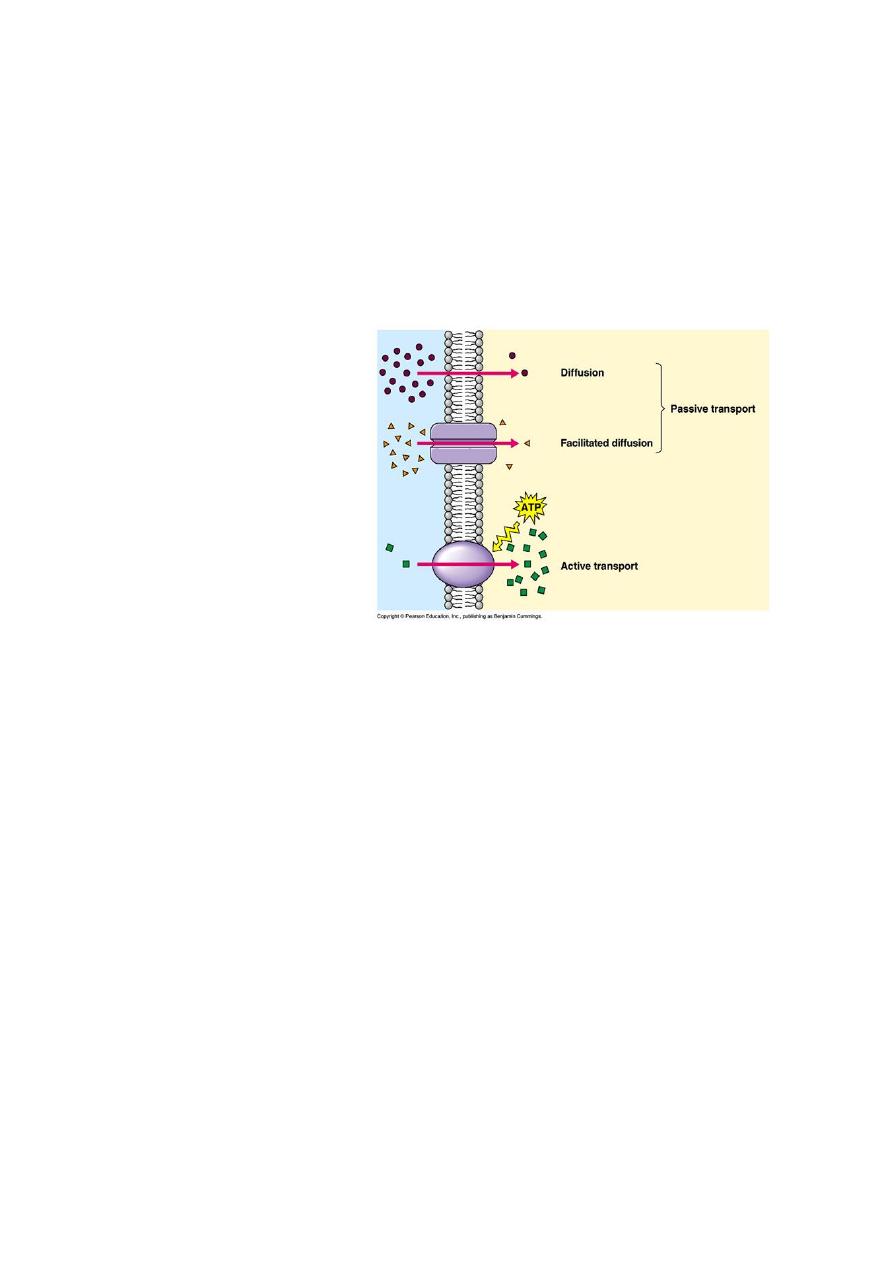
Movement across Cell Membranes
The cell membrane is selectively permeable and able to regulate what
enters and exits the cell, thus facilitating the transport of materials needed
for survival. The movement of substances across the membrane can be
either "passive", occurring without the input of cellular energy, or
"active", requiring the cell to expend energy in transporting it.
There are two ways in which substances can enter or leave a cell:
1) Passive ways
a) Simple Diffusion
b) Facilitated Diffusion
c) Osmosis (water only)
2) Active ways
a) Active Transport
b) Vesicle Transport
1) Passive ways
a.
Diffusion
Diffusion is the net passive movement of particles (atoms, ions or
molecules) from a region in which they are in higher concentration to
regions of lower concentration (down a concentration gradient) . It
continues until the concentration of substances is uniform throughout.
An example: gas exchange for respiration — oxygen from blood to tissue
cells, carbon dioxide in opposite direction.
b.
Facilitated Diffusion
This is the movement of specific molecules down a concentration
gradient, passing through the membrane via a specific carrier protein. Each
carrier has its own shape and only allows one molecule (or one group of
closely related molecules) to pass through. Selection is by size; shape ; and
charge. Common molecules entering/leaving cells this way include glucose
and amino-acids. It is passive and requires no energy from the cell.
(3)
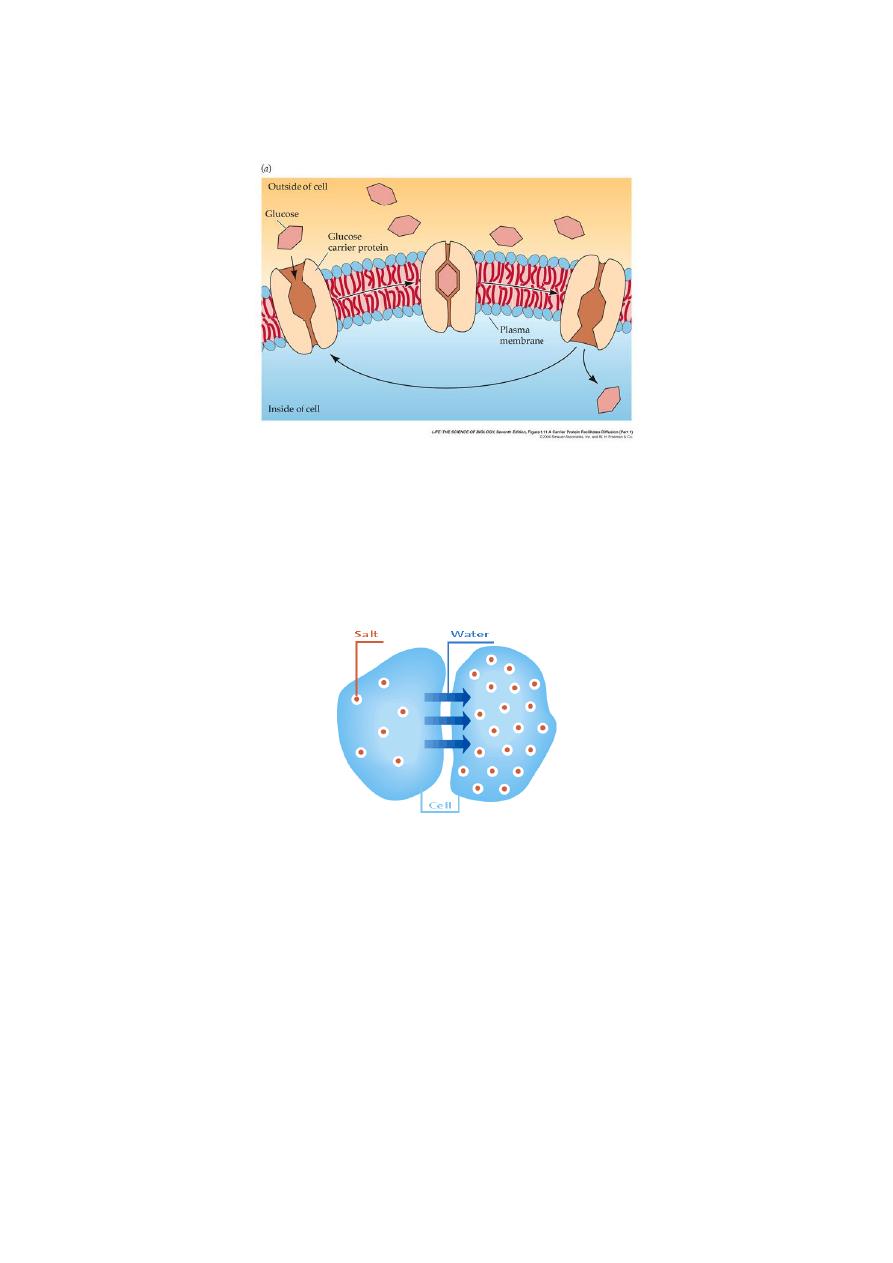
Facilitated Diffusion
c.
Osmosis
Osmosis is a special example of diffusion. It is the diffusion of water
through a partially permeable membrane from a more dilute solution to a
more concentrated solution – down the water potential gradient).
Note: diffusion and osmosis are both passive, i.e. energy from ATP is not
used.
The Effects of Osmosis
When an animal cell ( for example, the red blood cell) is placed in a
medium, which is a water solution , the possible consequences are listed
below:
1. If the water concentration inside the cell is the same as that in the
surrounding medium (the medium is an isotonic solution) there will
exist a dynamic equilibrium between the number of molecules of water
entering and leaving the cell and so the cell will retain its original size.
2. If the water concentration of the cell is lower than that of the medium
(the medium is a hypotonic solution) surrounding the cell then osmosis
will result in the cell gaining water
.
(4)
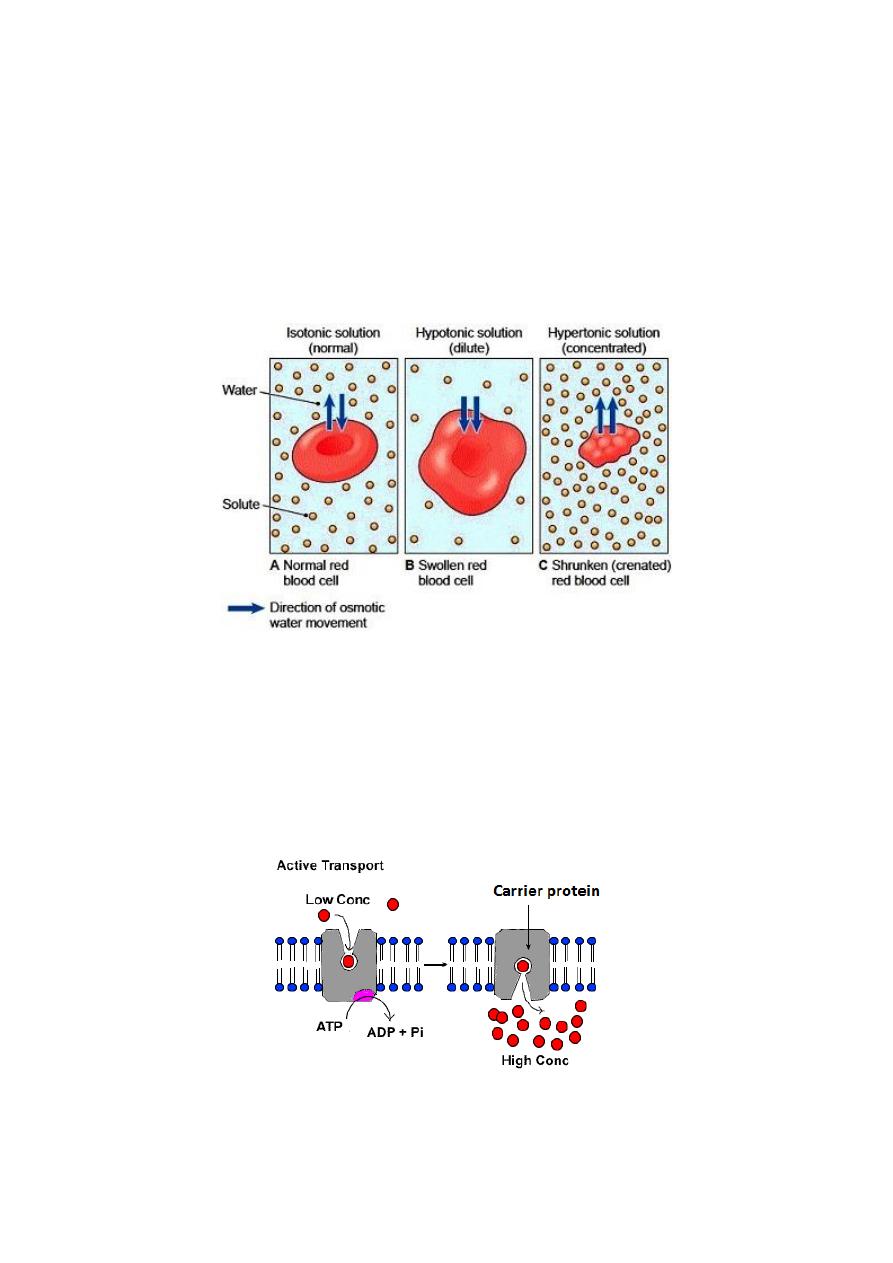
The water molecules are free to pass across the cell membrane in both
directions, but more water molecules will enter the cell than will diffuse
out with the result that water enters the cell, which will then swell up
and could possibly burst.
3. If the water concentration inside the cell is higher than that of the
medium ( the medium is a hypertonic solution) the number of water
molecules diffusing out will be more than that entering and the cell
will shrink due to osmosis.
2) Active ways
a. Active Transport
Active transport is the energy-demanding transfer of a substance across
a cell membrane against its concentration gradient, from lower
concentration to higher concentration. Special proteins within the cell
membrane act as specific protein ‘carriers’. The energy for active transport
comes from ATP generated by respiration (in mitochondria).
An example:
Sodium/potassium pump in cell membranes (especially nerve cells).
(5)

b. Vesicle Transport
Some molecules or particles are just too large to pass through the
plasma membrane or to move through a transport protein. So cells use two
other active transport processes to move these macromolecules (large
molecules) into or out of the cell. Vesicles or other bodies in the cytoplasm
move macromolecules or large particles across the plasma membrane
.There are two types of transport, endocytosis and exocytosis . Both
processes are active transport processes, requiring energy.
1. Endocytosis is the process of capturing a substance or particle from
outside the cell by engulfing it with the cell membrane. The
membrane folds over the substance and it becomes completely
enclosed by the membrane. At this point a membrane-bound sac, or
vesicle, pinches off and moves the substance into the cytosol. There
are two main kinds of endocytosis:
Pinocytosis (‘cell drinking’) This is the uptake of large molecules
(DNA, protein) from solution, by a form of endocytosis – the
vesicles formed are minute and short-lived.
Phagocytosis (‘cell eating’) This is the uptake of solid particles
by a cell e.g., Phagocytes engulfing bacteria.
2. Exocytosis describes the process of vesicles fusing with the plasma
membrane and releasing their contents to the outside of the cell.
Exocytosis occurs when a cell produces substances for export, such
as a protein, or when the cell is getting rid of a waste product or a
toxin. Newly made membrane proteins and membrane lipids are
moved by exocytosis.
(6)
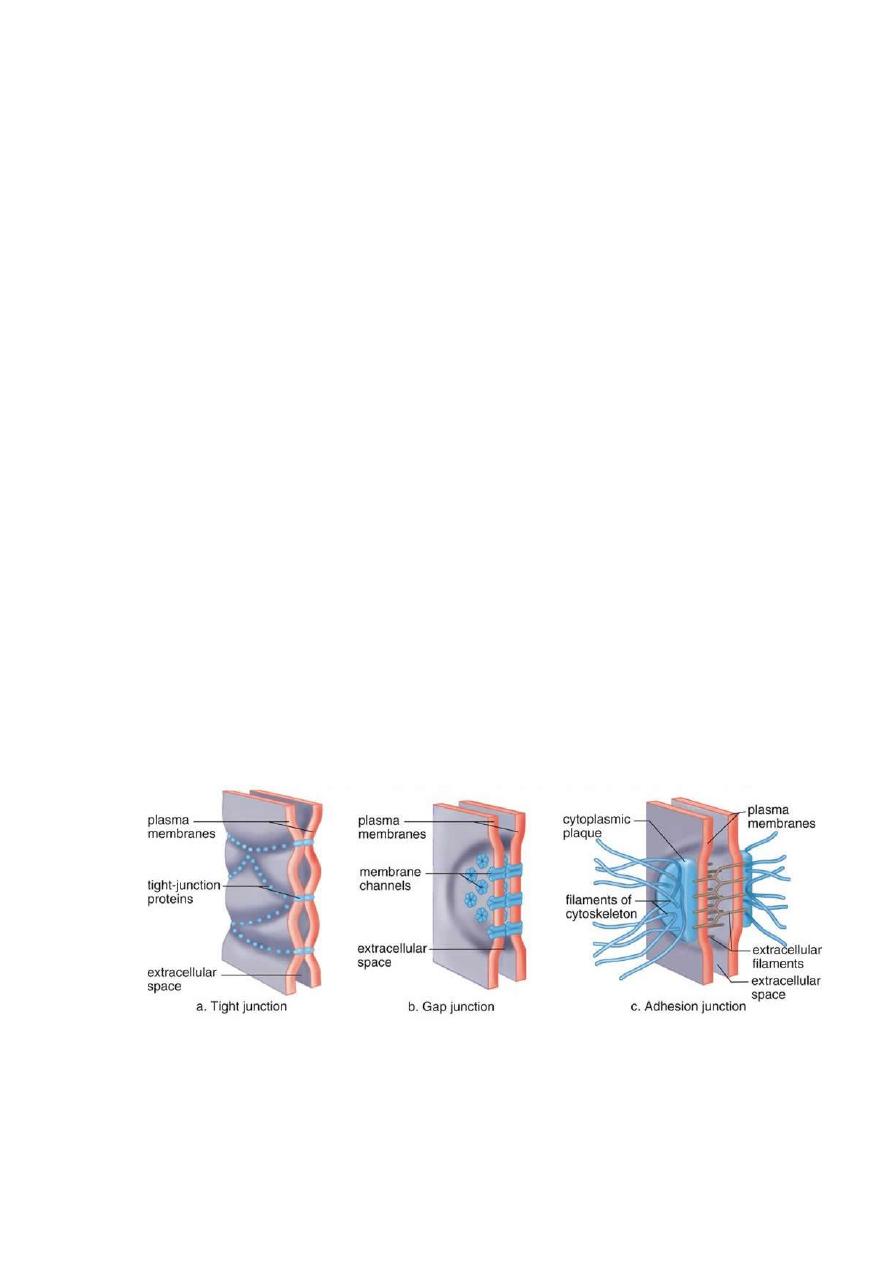
Cell membrane specialization.
The lateral of the cell membrane can show form "intercellular junction".
Function of these junctions:
1-They are the sites of adhesion between adjacent cell,
2-They prevent the flow of materials through the intercellular
3- They help in the cellular communication.
There are three types of junctions.
1-Adhesion junctions (desmosomes):
In this type, the internal cytoplasmic plaques firmly attached to the
cytoskeleton with intercellular filaments. Bladder, adhesion junction hold
cell together.
2- Tight junctions:
Adjacent cells are even more closely by tight junctions in which plasma
membrane proteins actually attach to each other producing a zipper like
fastening. These junctions between cells form an impermeable prevent the
flow of materials in intercellular space .e.g., in the kidneys the urine stays
within kidney tubules because the cells are joined by tight junctions.
3- Gap junctions:
It allow to communicate, and is formed when two inidentical plasma
membrane channels joins.The channel of each cell is lined by six plasma
membrane proteins (hexamears).Gap junction are important in heart
muscle and smooth muscle because they permit a flow of ions that is
required for the cells to contact.
(7)
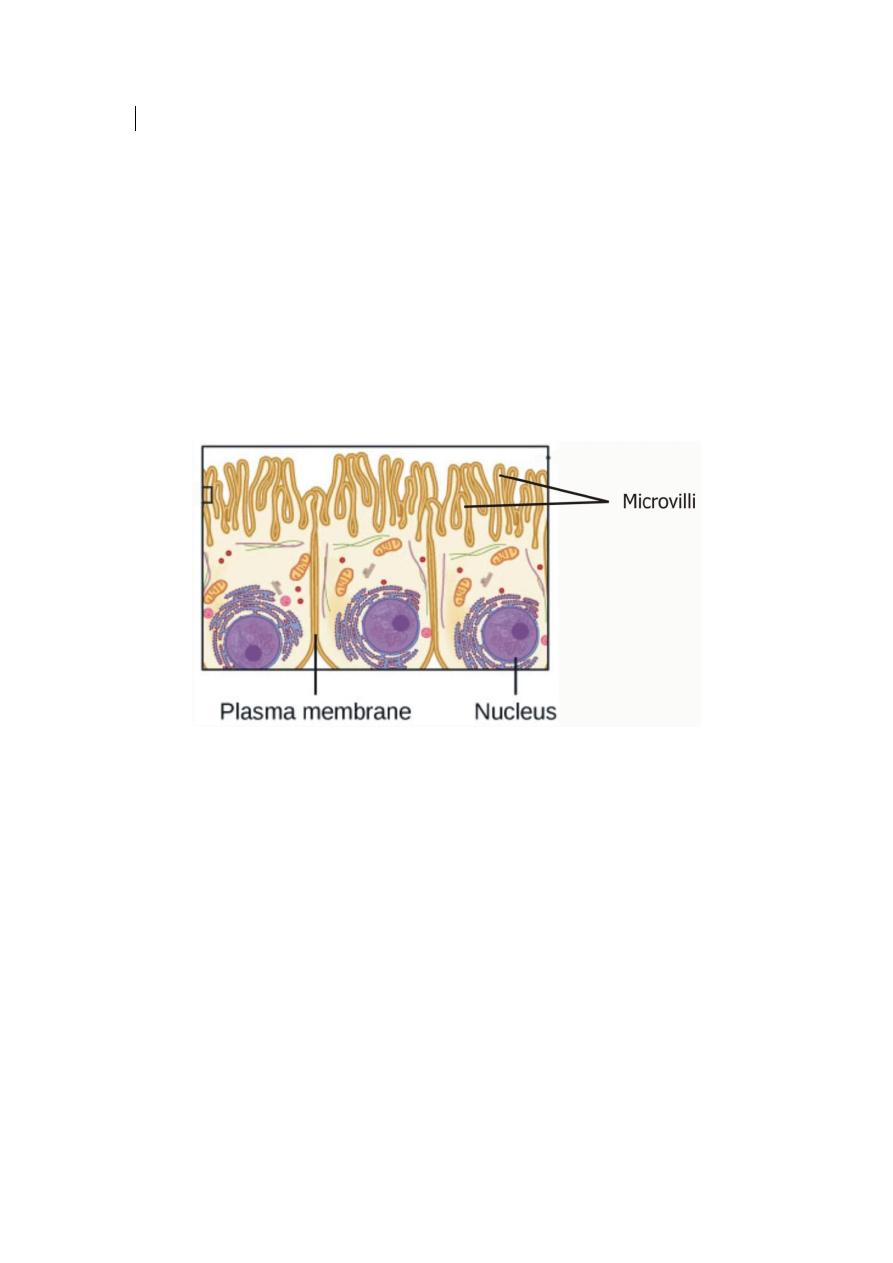
Apical modification of plasma membrane:
1. Microvilli:
Fingers like extensions of plasma membrane that are particularly
abundant on the surface of the cells, involved in the absorption, such as
the epithelial cells lining the intestine.
2. Stereocilia:
Specialized form of microvilli. The stereocilia of auditory hair cells, are
responsible for hearing by detecting sound vibrations.
(8)
